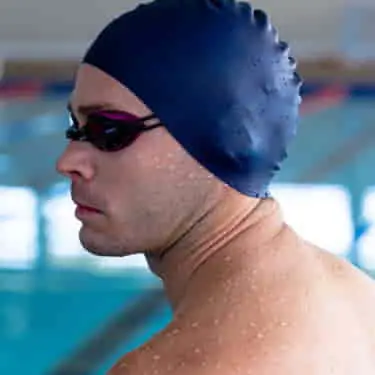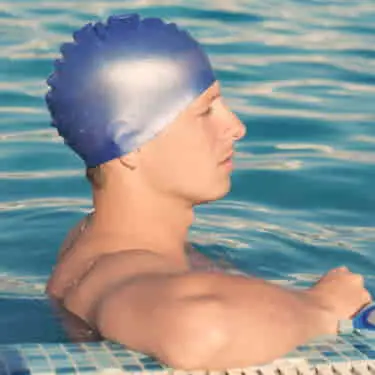Swim caps are an essential piece of swimming kit for many swimmers. Personally, I cannot get in the water to do length training without my swim cap. (I use the Speedo moulded swim cap which you can find on Amazon here)
As a general rule, swim caps are not designed to keep water out of the ear. Therefore, most swimmers wear caps in a position that partially covers the ears. Whether a swim cap fully or partially covers the ears depends on the preference of the swimmer.
In this article, I am going to answer:
- Should swim caps cover your ears?
- The pros and cons of wearing a swim cap over your ears
- Do competitive swimmers cover their ears with a swim cap
- Do swim caps keep water out of your ears?
- Do swim caps with ear pockets work?
- How should a swim cap fit?
Should Swim Caps Cover Your Ears?
There is much debate about the right way to wear a swim cap and if it should cover your ears.
There is no science to back up any benefits in fully covering your ears with a swim cap. Therefore, swimmers will either not cover their ears, partially cover their ears, or fully cover their ears with a swim cap, depending on what feels most comfortable.
For competitive swimmers, swim caps should be worn to cover the tips of the ears at least. Whether a competitive swimmer fully pulls their swim over their ears is a matter of personal taste and comfort.
The reason it is important for competitive swimmers to wear a swim cap and pin their ears in place is to create a streamlined head shape in the water.
Ears create drag in the water and for competitive swimmers where milliseconds count, having the most streamlined shape in the water is a top priority. Therefore, tucking their ears into a swim cap will make their head profile more streamlined and optimised for speed.
The Pros & Cons Of Wearing A Swim Cap To Cover Your Ears
The two images below show two swimmers wearing swim caps.
The first swimmer has their ears completely covered by the swim cap and the second swimmer has their ears partially covered by the swim cap.
Each way of wearing a swim cap will have benefits and disadvantages.
Swimmer With Swim Cap Fully Covering The Ears

Pros Summary
- Creates a streamlined head shape for an optimal swim as the ears create no drag
- The ear will be exposed to less water.
Cons Summary
- Air pressure will build up in the ear, so it may feel uncomfortable.
- Reduced hearing as the ear is covered.
Swimmer With Swim Cap Partially Covering The Ears

Pros Summary
- Reduced air pressure builds up on the ears, as the ears are still vented.
- Can still hear as normal.
Cons Summary
- The ear is exposed to more water.
Do Competitive Swimmers Cover Their Ears With A Swim Cap?
I always like to check out competitive pro swimmers to see how they wear their swim caps.
Here is a list of the top five female and male swimmers from the 2021 Tokyo Olympics 200m individual medley finals showing if they wear their swim caps over their ears:
| Swimmer Name | Country | How They Wear Their Swim Cap |
|---|---|---|
| Yui Ohashi | Japan | Ears Out |
| Alex Walsh | USA | Ears Partially Covered |
| Kate Douglass | USA | Ears Partially Covered |
| Abbie Wood | Great Britain | Ears Partially Covered |
| Yiting Yu | China | Ears Partially Covered |
| Shun Wang | China | Ears Covered |
| Duncan Scott | Great Britain | Ears Covered |
| Jeremy Desplanches | Switzerland | Ears Partially Covered |
| Daiya Seto | Japan | Ears Partially Covered |
| Michael Andrew | USA | Ears Partially Covered |
This list is some of the best and fastest swimmers in the world, and as you can see, there is some disparity between each athlete and if they wear their swim caps over their ears.
I find it fascinating that this year, Yui Ohashi from Japan won the Women’s 200m Medley at the Olympics in Tokyo with her ears out completely from her swim cap.
Even with all this professional coaching advice about pinning our ears back while we swim to go faster, she is a world champion and Olympic gold medal winner, with her ears comfortably sitting outside of her swim cap.
This proves that, at the end of the day, whether you should wear your swim cap over your ears is a matter of personal taste and comfort.
The one thing all these professional swimmers have in common is that they all wear swim caps to streamline their head shape for maximum speed in the water.
Do Swim Caps Keep Water Out Of Your Ears?
Swim caps alone do not keep water out of your ears.
If you want to keep water out of your ears, using swim ear plugs are more effective. My favourite swimming ear plugs are the Zoggs Aqua Plugz, (which you can view on Amazon here)
I have found that the best approach to keeping water out of ears while swimming is to wear ear plugs and a swim cap together. If you want extra protection, you can pull the swim cap completely over your ears.
This has the benefit of keeping your ear plugs in place and really reducing the exposure of the ear to water.
However, you may find that wearing ear plugs with a swim cap will create excessive pressure on your inner ear that some people find uncomfortable. For me personally, this is a feeling I do not enjoy.
Unfortunately, there is no way to check if wearing your swim cap over your swimming ear plugs is the right solution for you unless you physically try it in the water.
Trying to keep water out of your ears while swimming is very difficult and I have yet to find a solution that is 100% waterproof.
To learn more about swim ear plugs, check out my article, Do Swim Ear Plugs Work?
For a list of the best swimming earplugs for swimmers, check out my review of the 7 best earplugs for swimmers. I tried so many types!
Do Swim Caps With Ear Pockets Work?
As pulling your swim cap over your ears can feel uncomfortable as it places too much pressure on the ear, some manufacturers have developed swim caps with ear pockets. (Here is a link to what these look like on Amazon)
These are swimming caps with extra space around the ear, so the swim cap covers the ear but does not press down on it.
Overall, these swim caps with ear pockets are well-reviewed and seem to fit most people well.
Typically, these swim caps are also designed for those with longer hair, as they typically seem to be more generous in space.
Because the swim cap covers the ear, the swim hat will come down past the ear and the hairline. This makes these types of swim caps generally better at creating a watertight seal.
Although no swim caps are 100% waterproof, these particular types are a lot more efficient at keeping water away from the hair and ears.
How Should A Swim Cap Fit?
When fitted correctly, a swim cap should feel comfortable on your head without pulling on your scalp, cover all your hair and sit just below the hairline. If you prefer, you can pull the swim down over your ears to cover them.
We all have different shapes of head and hair types, but there are some general guidelines that you can follow to ensure your swimming cap is fitting well.
Step 1 – Tie Up Your Hair In A Bun
Step 2 – If there is a seam running through your swimming cap, this should run down the middle of your head. Orientate your swim cap correctly.
Step 3 – Place your hands on either side of the swimming cap.
Step 4 – Pull the swim cap onto your head from front to back, ensuring the front of the swim cap is just below your hairline.
Step 5 – Tuck in all your hair under the hat.
Step 6 – If you prefer, pull your swim cap completely over your ears or just partially over your ears. This step is optional and depends on your preferences.
Here is a demonstration of how you should fit a swim cap:
Final Thoughts
I typically swim with my swim cap partially covering my ears. This allows my ears to hear as normal and prevents the build-up of pressure from within the ear.
I understand why swimmers want to cover their ears completely, as pool water can cause infection if left in the ear.
To prevent swimmer’s ear, you should always follow a post-swim ear care routine, to ensure your ear is 100% dry after swimming.
How you wear your swim cap, either over your ears or not, is a matter of personal taste.
For more information about swim caps and if they actually keep hair dry, check out my article, Do Swim Caps Keep Hair Dry?
Finally, before you go, I just want to tell you about my new mindful journal and swimming log book, “The Mindful Swimmer” as I am super excited about it! This is a 180-day mindful journal and swim log book to help us swimmers track and get the most from our daily swims. Check it out here on Amazon.
Happy swimming!
